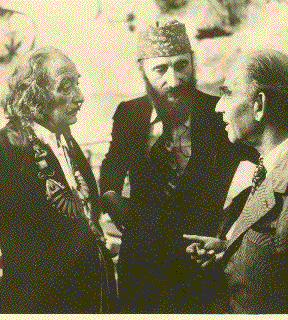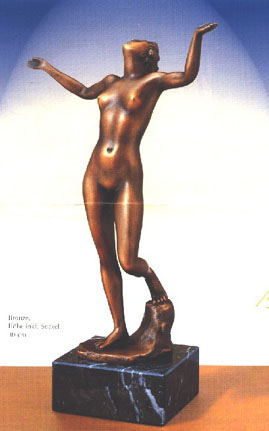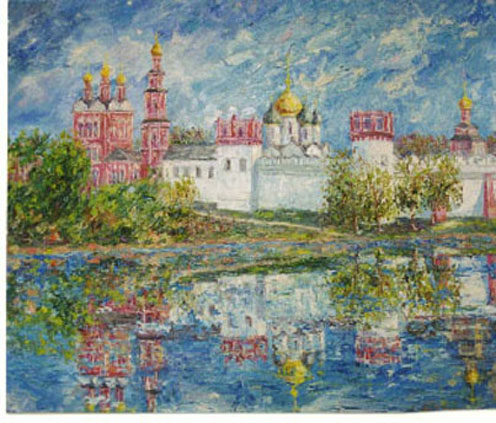The Museum of European
Art is a new way of promoting art.
In a democracy, private
engagement is needed more than ever
By Joe F. Bodenstein
This article was first published in the
prominent monthly Russian art magazine ART COUNCIL, September 2005
issue.

The
Golden Triangle:
Salvador
Dalí,
Ernst
Fuchs
and Arno
Breker.
The works of these three artist-friends are the cornerstone of the
collection of the US Museum of European Art.
Copyright: Museum Arno Breker, Nörvenich
New York/Moscow (bpb) The US
Museum of European Art (MEAUS) is a privately financed non-profit
institution in the United States.
Its goal is to support
artists of our time by introducing their works to the public.
The founder of the
Museum, Consul B. John Zavrel, has been since the very beginning
interested in using art for better understanding between the people
of the West and East.
Zavrel's valuable
contribution is to introduce highly talented sculptors, painters and
photographers, who are not much known in the public.
In the international dialog for the artists,
Zavrel has been using his contacts to high-ranking politicians:
Ronald Reagan, George Bush, Vaclav Havel, German presidents and
ministers. "It is good to have their approval of our engagement to
use art for better understanding", said Zavrel. "But it seems easier
in politics to get billions of dollars for weapons, than a thousand
dollars for cultural engagement."
The success of MEAUS is based on the honesty and
the realistic views of Zavrel. The American of Czech background--like
Andy Warhol--established the Museum in a small building in Clarence,
New York.
The Museum is still looking for sponsors for a
larger building. "We use the modern technical communications to
inform the public world-wide about our activities", said Zavrel in an
interview. "The world-wide web is a big help. Our internet bulletin
PROMETHEUS for Art, News, Politics and Science is an excellent
platform to introduce to its readers interesting people of our time,
who have something to say in art. An artist is not great if he is
popular in the media, but he is unique by the quality of his
artworks."

'The Goddesses of Fate of
Antiquity', one of the
latest sculptures by Renate Stendar-Feuerbaum.
The 85-year old Swiss
lady sculptor is well represented in the Museum's permanent
collection.
Copyright: European Art Foundation (EKS), Berlin
This is a fact: Artists in a democratic society
need more than ever before a private engagement to bring them ahead.
In a centrally guided state--or a so-called dictatorship as we had in
the Third Reich in Germany or in the Soviet Union with the leader
Josef Stalin--a certain group of artists were supported by the
government officials. The government built great works of
architecture, and supported the realistic art. In this way were
created monuments, which remind us of great successes in a given
political period. At the same time, the former governments in the
United States had also commissioned artworks that the American people
and the visiting tourists alike still admire today.
In the United States, historical buildings and
monuments were mostly sponsored by private people. The famous Statue
of Liberty in New York is a present of France. We find similar
symbols and famous landmarks also in Russia, from her eventful past.
It is to be hoped that they will be preserved as a reminder of the
history of the 20th century, and will not become victims of
vandalism.
The richness of cultural collections in the United
States is based on old families and individual collectors. Since the
end of the Second World War and the fall of the Hitler empire, the
realistic art has been discriminated against by official
institutions. "It is our duty to give the classical artists new
chances and hopes", said Zavrel. "Nobody should forget: the realistic
art is the foundation of modern art. Without craftsmanship, a person
cannot create artworks of fundamental value."
This opinion is shared by the European Art
Foundation (EKS) in Berlin. This privately financed institution
co-operates with the Museum of European Art by supporting its art
exhibitions. "Our policy is to arrange exhibitions, bringing artists
of our time together with the great names of the past like Marc
Chagall, Pablo Picasso, Arno Breker, Henry Matisse, Aristide Maillol
and Auguste Rodin," said the EKS curator Kurt Arentz. He himself is a
sculptor and an open-minded personality.

'MONASTERY',
an oil painting by the Russian-born painter Binyamin
Shalumov.
Copyright: B. Shalumov, New York
Russia is a land of culture and
high traditional values
Zavrel has proved his interest in the art of
Eastern Europe. He exhibited works of sculptors and painters from the
Czech Republic, Russia, Hungary, Poland, Rumania and Bulgaria. On
several occasions, MEAUS has exhibited the interesting paintings of
the much respected and admired Russian-born painter Binyamin
Shalumov, who now lives in the United States.
"Much more could be done, if we can find private
sponsors in the former Soviet Republics", said Zavrel. "The artists
of our time need commissions. It would be a wise investment of the
new rich society in Russia to buy sculptures and paintings by Russian
and European artists to show the cosmopolitan spirit of the New
Generation. Investing in Art is much better than to spend money only
on vacations in Monaco and with the high society on the beaches along
the French vacation coast Côte d'Azur."
The Museum of European Art has attractive works by
a number of highly valued European artists of our era. The Museum can
make these works available to Russian collectors, as well as to all
friends of classical art in USA and Europe. Contact zavrel@meaus.com
"Russia is a land of culture and high traditional
values", said the curator Kurt Arentz. It would be great, if in
prosperous times the new Russian generation spends some money also on
the art of lasting value. "Over the years of the Cold War, Russia has
kept the public's interest in Europe and the United States mainly
thanks to her literature, music, architecture and art. To continue
this tradition is a permanent responsibility of the wealthy people,
to bring and keep Russia at the top of international
reputation.
For more information see the
following web sites:
www.meaus.com,
www.europaeische-kultur-stiftung.org,
www.museum-arno-breker.org
© PROMETHEUS 99/2005
Keep informed - join our
newsletter:
Copyright 2005 Museum of European Art
PROMETHEUS, Internet Bulletin for Art, News, Politics and
Science.
Nr. 99, SEPTEMBER 2005
